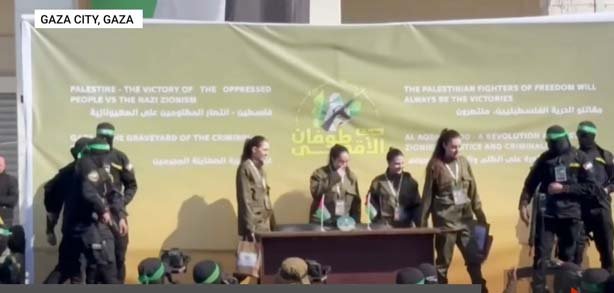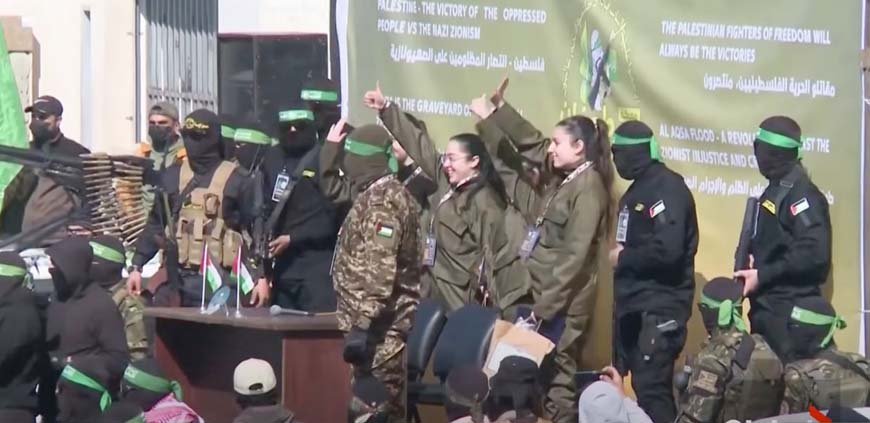January 25, 2025
In a gesture that delivers a glimpse of hope among decades of antagonism, Hamas has released four Israeli soldiers as part of a high-profile prisoner exchange arrangement. In reaction, Israel freed 200 Palestinian detainees, marking a crucial milestone in the tenuous peace arrangement between the two sides.
The argument underlines the complexities of the continuous Israeli-Palestinian conflict and reveals the emotional, political, and humanitarian components of this decades-long war.
Who Were the Released Hostages?
The four soldiers—Karina Ariev, Daniella Gilboa, Naama Levy, and Liri Albag—were taken on October 7, 2023, during Hamas’ surprise assault on the Nahal Oz military base near the Gaza border. For over 15 months, their families faced the misery of separation, without knowing the fate of their loved ones.
The release of these ladies has been welcomed with overwhelming relief and jubilation across Israel. Upon their arrival return on Israeli soil, they were promptly transferred to a secure medical facility for physical and psychological tests. Naama Levy’s mother, speaking to local media, said, “When I hugged her for the first time in over a year, it felt like life was restored to me.”
The Prisoner Exchange Deal in Detail
The handover forms part of a broader truce arrangement mediated by Egypt, Qatar, and the United States. Over a 42-day period, the deal will see 33 Israeli captives released by Hamas in return for the release of 1,900 Palestinian detainees detained in Israeli jails.
According to The Times, the Palestinian inmates released thus far include individuals charged with petty charges, as well as those accused of participating in violent resistance actions. Many of these prisoners were met with massive celebrations upon their return to their villages, where they are generally seen as symbols of resilience and defiance.
The Israeli government has defended the trade as a necessary compromise to guarantee the safety of its residents. However, the pact has garnered criticism from certain sectors within Israel who believe that such transfers may strengthen Hamas and threaten Israeli security.
Challenges and Controversies
Despite the success of this conversation, tensions remain high. Notably, civilian hostage Arbel Yehud, who was also abducted during the October 2023 attacks, has not been released. This has prompted severe criticism from the families of civilian captives, as well as from human rights organizations.
Israeli Prime Minister Benjamin Netanyahu has taken a firm stance, declaring that the return of displaced Palestinians to northern Gaza will be delayed until all Israeli civilian detainees are liberated. “Our duty is to bring every Israeli citizen home. No exceptions,” Netanyahu declared during a press conference.
Hamas, in turn, has accused Israel of breaking the conditions of the ceasefire agreement by continuing surveillance missions over Gaza.

Broader Implications for the Region
The deal has not only brought brief solace but also raised concerns about the greater repercussions for the Israeli-Palestinian conflict.
The freeing of Palestinian captives has fueled calls for broader acknowledgment of Palestinian rights and independence. Meanwhile, Israeli officials continue to underline the need for stringent security measures to protect their population.
International groups, like the United Nations and the International Red Cross, have welcomed the exchange but urged both sides to use this momentum to address the underlying causes of the conflict. “While this exchange is a humanitarian milestone, it should be the beginning of a larger conversation on lasting peace,” said António Guterres, UN Secretary-General.
The Emotional Cost of War
The liberation of hostages and inmates has emphasized the horrific human toll of the fighting. For the relatives of the liberated captives, the past 15 months have been a nightmare. “You spend every day waiting for a phone call, a sign, anything that tells you they are alive,” said Eli Gilboa, father of one of the troops.
Similarly, Palestinian families who welcomed home their loved ones after years in Israeli captivity offered their stories of endurance. Ahmed Khalil, whose son was released as part of the exchange, stated, “Every day we prayed for this moment. My son wasted years of his life in prison, but today we feel entire again.”
However, for those still waiting, the suffering endures. Hundreds of Israeli and Palestinian families remain in limbo, uncertain about the fate of their loved ones.
Hope and Uncertainty Moving Forward
While the swap has provided a brief reprieve, the future remains uncertain. Experts caution that the truce, however encouraging, is fragile and liable to collapse if confidence between the sides continues to deteriorate.
The coming weeks will be key in determining whether this exchange acts as a stepping stone toward resumed peace talks or merely a break in the cycle of conflict. Both parties face great pressure from their communities and the international community to find a route ahead.
Sources:
- The Times: Hamas Names Israeli Hostages
- AP News: Hamas Releases 4 Israeli Soldiers
- The Sun: Hostages Set to Be Released Today
- New York Post: Israel to Accept Hostage Exchange
- Human Rights Watch: Report on Gaza Humanitarian Crisis

